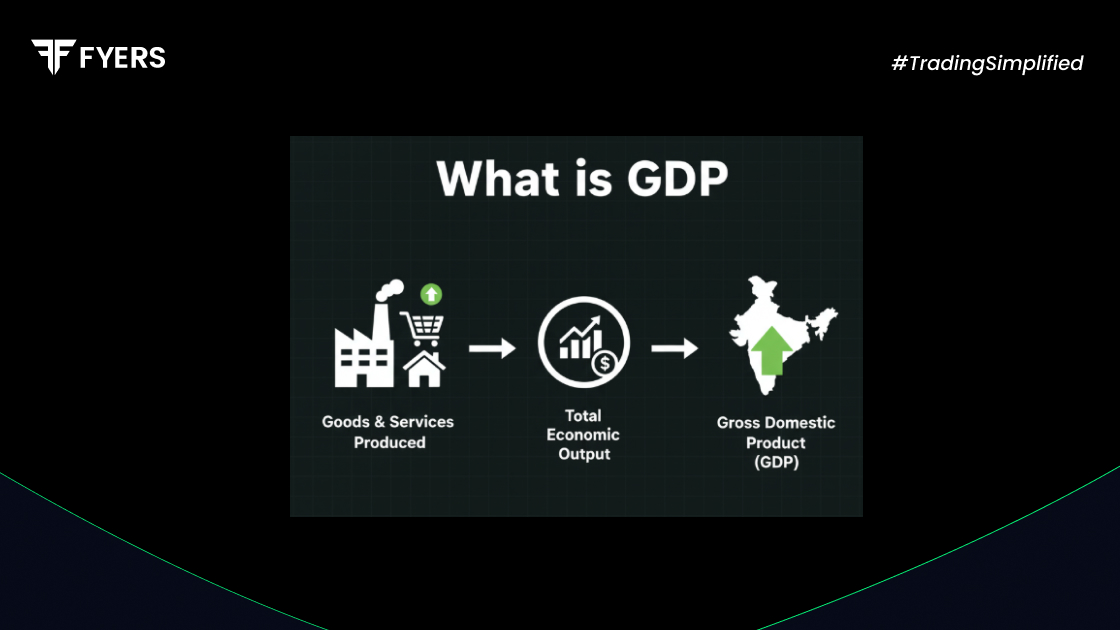

 25 Sep, 2025
25 Sep, 2025
 4 mins read
4 mins read

Understanding the gross domestic product of a country is key to grasping its economic performance. From policymakers to investors, GDP acts as a yardstick for growth, income, and overall economic health. Whether you are comparing economies, planning investments, or following financial news, knowing what GDP represents and how it is calculated helps make sense of the bigger economic picture.
GDP is the total monetary value of all finished goods and services produced within a country’s borders over a specific period, usually a quarter or a year. It covers output from all sectors including agriculture, manufacturing, services, and construction.
A rising GDP generally signals economic growth, more jobs, and higher income, while a declining GDP can indicate slowdowns, reduced business activity, and potential job losses.
There are several ways to measure GDP, each providing a different view of economic activity:
Nominal GDP: Measures the value of goods and services at current market prices without adjusting for inflation.
Real GDP: Adjusted for inflation, showing the true growth in output rather than price increases.
GDP at Factor Cost: Excludes taxes and includes subsidies, representing the cost of production from the producer’s perspective.
GDP at Market Price: Includes taxes and excludes subsidies, reflecting what consumers actually pay.
GDP Per Capita: Divides GDP by the total population, giving an average income per person and enabling comparisons across countries.
|
Aspect |
Description |
Example / Notes |
|---|---|---|
|
Types of GDP |
Different ways to measure economic activity |
Nominal GDP, Real GDP, GDP at Factor Cost, GDP at Market Price, GDP per Capita |
|
Nominal GDP |
Value of all goods/services at current prices |
Not adjusted for inflation |
|
Real GDP |
Inflation-adjusted GDP |
Shows true growth in output |
|
GDP at Factor Cost |
Excludes taxes, includes subsidies |
Reflects production cost from producer’s side |
|
GDP at Market Price |
Includes taxes, excludes subsidies |
Reflects what consumers actually pay |
|
GDP per Capita |
GDP ÷ total population |
Measures average income per person |
|
Calculation Approaches |
Ways to calculate GDP |
Production/Output, Income, Expenditure (C+I+G+X-M) |
|
GDP vs NDP |
Difference in accounting for depreciation |
NDP = GDP − Depreciation; shows net production |
|
Importance |
Why GDP matters |
Policy decisions, investment planning, international comparison, standard of living, forecasts |
|
Limitations |
What GDP does not capture |
Income distribution, non-market activities, quality of life, environmental impact, shadow economy |
GDP can be calculated using three main approaches:
Production (Output) Approach
Adds up the value of output produced by all industries in the economy.
Income Approach
Totals all incomes earned by individuals and businesses, including wages, profits, rent, and taxes minus subsidies.
Expenditure Approach (most commonly used)
The formula is:
|
GDP = C + I + G + (X - M) |
C = Private consumption
I = Investment
G = Government spending
X = Exports
M = Imports
Where:
This approach measures the total spending on a country’s goods and services.
NDP (Net Domestic Product) is derived from GDP but accounts for depreciation of capital goods:
|
NDP = GDP - Depreciation |
While GDP measures total production, NDP provides a clearer view of sustainable economic output by considering the wear and tear of assets.
|
Metric |
Definition |
Key Difference |
|---|---|---|
|
GDP |
Total output without subtracting depreciation |
Measures gross value |
|
NDP |
GDP minus depreciation of capital goods |
Measures net value after wear and tear |
GDP is a crucial economic metric for several reasons:
Policy-making: Guides governments and central banks in decisions on interest rates, taxation, and spending.
Investment planning: Helps investors assess growth trends and make informed choices.
International comparison: Allows comparison of economic strength between countries.
Standard of living: GDP per capita indicates average income and wellbeing.
Economic forecasts: Provides insights for predicting future growth or recessions.
Despite its importance, GDP has several limitations:
Ignores income distribution: Growth may benefit only a small segment of the population.
Excludes non-market activities: Unpaid work like household labour is not counted.
No measure of quality: More goods do not always mean better living conditions.
Environmental impact: GDP does not account for natural resource depletion or pollution.
Shadow economy: Informal sector activities are often unreported.
GDP should therefore be used alongside other indicators for a complete understanding of economic wellbeing.
Gross domestic product remains the primary tool for assessing a country’s economic output. It helps understand growth trends, guide policy, and compare economies worldwide. However, its limitations highlight the need for additional indicators to evaluate true development and quality of life. Understanding GDP is essential for anyone seeking to follow or participate in economic and financial decisions.
GDP is the total value of all goods and services produced within a country over a specific period, showing how much an economy is producing and its overall performance.
Nominal GDP uses current prices and does not adjust for inflation, while real GDP removes the effect of inflation to show actual growth in output.
GDP per capita divides the GDP by the total population, indicating average economic output per person and enabling comparison of living standards between countries.
GDP is useful for measuring economic activity but does not capture income inequality, environmental impacts, or quality of life. Other indicators like the Human Development Index provide a broader view of development.
Calculate your Net P&L after deducting all the charges like Tax, Brokerage, etc.
Find your required margin.
Calculate the average price you paid for a stock and determine your total cost.
Estimate your investment growth. Calculate potential returns on one-time investments.
Forecast your investment returns. Understand potential growth with regular contributions.